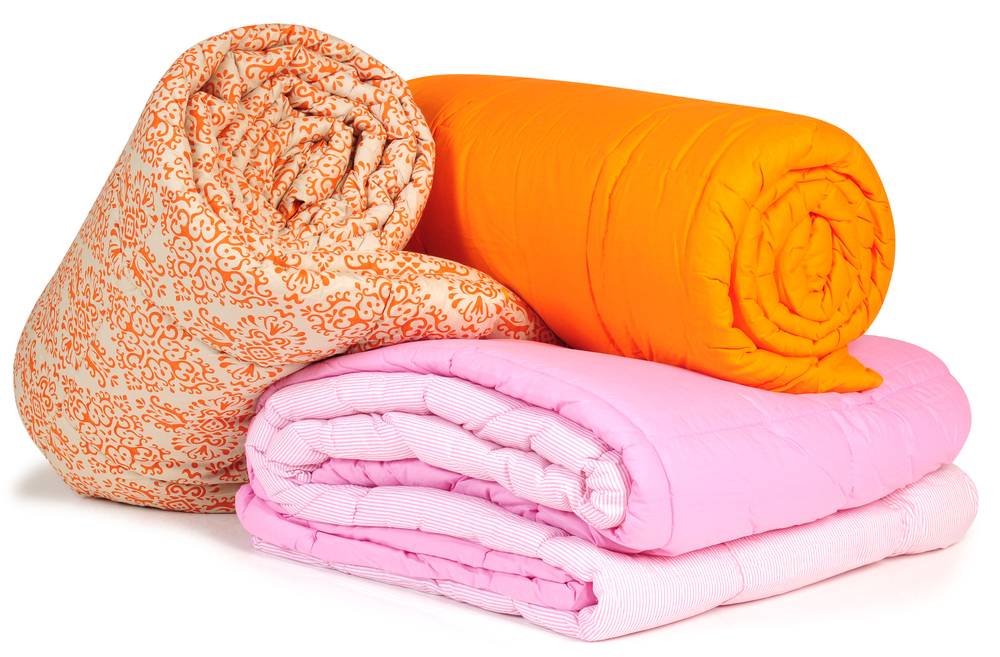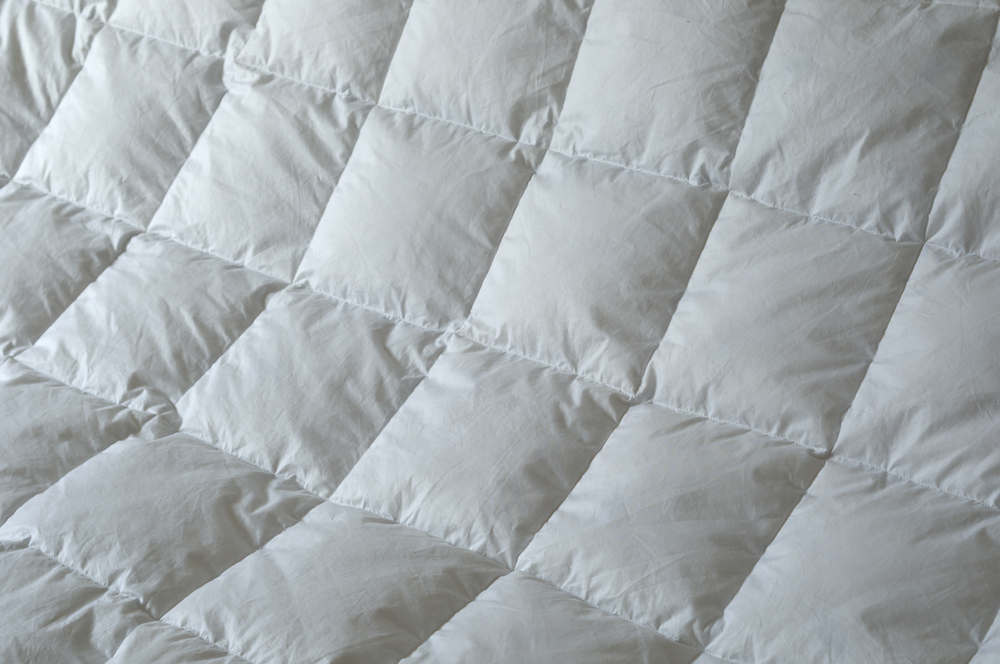Duvet vs Comforter: Whats The Difference?

While duvets and comforters essentially serve the same purpose, they’re distinctively different bedding items that vary in plushness, design, and care instructions. Knowing the potential benefits and drawbacks of each can help you choose the right cover for your bedding needs.
This comparison guide will explain the main difference between a duvet and a comforter and how they compare in areas like convenience, durability, and warmth. We'll also closely examine the various fill and shell materials of duvets and comforters and how they perform, to help you make an informed decision.
What's a Duvet?

"Duvet" is basically a French word for down. Traditionally, duvets are filled with down feathers - a fine layer of feathers found under the exterior feathers of ducks and geese. Today, duvets are also filled with other materials like wool, synthetic fabrics, down alternatives, or silk.
So, what's a duvet?
Simply put, duvets are quilted blankets typically filled with natural or synthetic fillings protected by interchangeable covers. Unlike comforters, their unique pillow-like structure traps body heat without weighing the sleeper down.
Duvet Cover
A duvet cover is a fabric that fits around your duvet for added protection. Like your bed pillow in its pillowcase, duvet covers have one side open to make them removable. Their openings may be closable with snaps, zippers, or buttons to keep your duvet from slipping out.
Generally, a duvet cover has three main functions: design, comfort, and convenience. For instance, if you're interested in adjusting the look of your sleep environment, purchasing a duvet cover can be a simple and relatively inexpensive solution. While most duvets come in white and off-white, several duvet cover alternatives can match your bedroom's changing style.
Duvet cover materials also allow you to change from one style to the other with ease. One can easily shift from the soft flannel 0n the cold days of January to lighter cotton once spring arrives.
Lastly, a duvet cover adds a protection layer to your duvet, safeguarding it from sweat, body oils, spills, and general wear. Although you still have to keep your duvet clean, you can wash it less often thanks to the cover.
Duvet covers are usually machine-washable and are lighter and thinner, which makes them much easier to wash than a comforter or a full duvet. Always check the manufacturer's cleaning guidelines for your duvet and the cover just to be sure you're maintaining them properly.
Duvet Insert
The term "duvet insert" is simply another way of saying duvet. The primary reason for specifying it as an insert is to differentiate it from the cover.
Duvet inserts are normally in solid, light colors, like white or off-white, since they tuck inside the cover. The covers are meant to complement the inserts' look and feel while protecting them from damage.
What's a Duvet Made of?
The duvet insert or the duvet itself is specially designed to last for years and adjust comfortably to different sleeping preferences. A duvet set comes in two parts: the filler and the removable cover. Just like shopping for mattresses, comforters, and sheets, the materials determine your bed's softness, weight, and temperature control.
Duvet Shell
Duvets generally comprise shell and filler materials. Also known as ticking, the shell is often made of cotton or artificial fibers. Most duvet shell materials are long-lasting, highly breathable, and easy to clean and maintain. They're often available in white, cream, or gray, suitable for various duvet cover designs.
Duvet Filler
The duvet filler goes inside a duvet, offering different levels of physical weight and breathability. They come in natural or synthetic fibers, with feathers or down being the most traditional alternatives. The duvet filling material is evenly distributed throughout your duvet for even comfort. Other popular material options include cotton, microfiber, wool, silk, and polyester.
Pros and Cons
Choosing between a comforter and a duvet is majorly a matter of sleep preference and needs. It's about establishing the perfect environment for a good night's sleep. While duvets deliver much more flexibility for your bed's look and feel, some sleepers find it hard to keep them in place. Also, many individuals simply love a comforter or a bed sheet set's traditional layered feeling.
Below, are some of the pros and cons of duvets:
Pros
- Easy to care for. Rather than washing your duvet insert very often, you simply need to wash the cover regularly to keep it fresh and clean. To clean your duvet, you just need to remove the cover and toss it into your washing machine.
- Flexibility to change the duvet cover by season and style. A duvet allows you to stockpile a bunch of covers and swap them for your warm-weather and cold-weather moods.
- Multiple options at various price points. Whether you're shopping on a budget or ready to spend more cash on a luxurious duvet, you'll be glad to know there's a duvet that suits your unique needs and desired price.
- Fluffier than comforters. Most duvets feature a higher fill power, meaning sleepers will get a more insulated feel.
Cons
- Most duvet covers are sold separately. While most sheet sets feature duvet covers, others don't, so if you go this route, you may have to invest in other bedding accessories.
What's a Comforter

Typically, comforters are thick, quilted, fluffy blankets that sleepers use to keep themselves warm. They usually lie on top of blankets or flat sheets and feature down or a synthetic substitute.
Multiple layers make a comforter much warmer than a traditional blanket. Its outer shell is made of breathable material with a plush surface. But you can also find many fuzzy and other textured alternatives.
Comforters' shell and fill materials significantly affect their performance and longevity. Natural materials are usually effective at temperature regulation, while synthetic alternatives are much easier to clean. And if you enjoy a warm, fluffy surface, you may want to go for a comforter rather than a thinner covering like a quilt.
With a comforter, you can add both warmth and style to your bedroom and create a perfect sleep environment without breaking the bank. You can always use your comforter with a top sheet to protect it from dirt, spills, and general wear.
What's a Comforter Made Of?
Comforters are designed with natural or synthetic materials. Some even come with both synthetic and natural materials. As mentioned earlier, natural materials, such as wool and feathers, are prized for comfort and breathability. On the other hand, synthetic materials, such as down alternatives, are made from polyester and are often easier to clean.
Comforter Shell
The comforter shell is the fabric pouch that encases your comforter's fill and determines how it will appear and feel. Understanding the specific types of shells on the market will help you decide which option is best for your needs.
Cotton Shells
Cotton shells can significantly improve your comforter's airflow and simplify cleaning. They can be classified as long-staple, short-staple, or extra-staple based on the measurements of the fibers. Shells with long-staple cotton varieties are often smooth, plush, and breathable.
The feel of your cotton shell will also vary greatly depending on your fabric's weave. For instance, a sateen shell always tends to be silkier and cozier. A percale shell, on the other hand, is crisper and cooler.
Silk Shells
As a natural fiber, silk is made of the cocoons of insects like silkworms. This material is luxuriously plush, cool-to-the-touch, and can feel slightly more slippery than other fabrics. While silk is good at regulating body temperature, its delicate nature calls for extra care. And since the material feels slippery, preventing nighttime shifting may be more challenging.
Eucalyptus Shells
Eucalyptus-derived shells generally comprise rayon or lyocell made from processed wood pulp fibers. They tend to feel soft and silky, especially if you're using one with a sateen weave. When it comes to performance, eucalyptus shells are breathable, cool to the touch, and boast moisture-wicking properties. This makes them suitable for warmer climates. And if you've got sensitive skin, you'll be glad to know that your skin won't negatively react to the shell's smooth surface.
Comforter Fills
Most comforter fillers are made of polyester, wool, cotton, down, or a down alternative. They act as an insulating material, mainly to keep sleepers warm. Comforters feature a sewn-through pattern to keep the fills evenly distributed and prevent them from clumping together.
Down Fills
Derived from white duck or goose feathers, down fills are among the higher-end alternatives in the market. Although it's fluffier and lighter than wool, it delivers similar warmth. Cleaning a down feather comforter requires extra care. This is because it's not machine-washable, meaning you can only dry clean it, making it expensive to maintain.
Down Alternative Fills
Down alternative fills consist of synthetic materials, often made of polyester, that imitate the down's fluffiness. The volume and the quality of the fill will determine the breathability and warmth of your comforter. While the down alternative is also soft and warm, it doesn't match the down's insulating properties. However, it's resistant to allergens and much easier to clean.
Wool Fills
Wool-filled comforters are thicker and heavier than other comforters and are a perfect alternative for cold climates and individuals who prefer maximum insulation. They offer unmatched warmth and have the added advantage of being naturally moisture-wicking. While most comforters are machine-washable, you must take precautions to avoid damage.
Cotton Fills
Cotton-filled comforters are the ultimate lightweight alternative for the summer and winter seasons. Cotton fills tend to be soft, breathable, and highly absorbent. Plus, they're hypoallergenic, meaning they won't irritate the skin. Generally, cotton-filled comforters are an ideal all-around pick, a bit fluffy and 100% vegan.
Eucalyptus Fills
Eucalyptus fills feature rayon or lyocell made of cellulose fibers. They boast a plush, down-like feel and are well-known for their temperature-regulating properties, wicking away moisture and heat to provide year-round comfort.
Pros and Cons
Here are some of the pros and cons of using a comforter:
Pros
- They often come in bedding sets. Most comforters come in sets with coordinating blankets or pillow shams, making your mattress dressing even easier.
- Easy to put on the bed. Unlike duvets, comforters are ready to go out of the bag. You don't have to purchase an additional cover and wrap your comforter in it before spreading it on your bed.
- Affordable. If you're shopping on a tight budget, comforters can give you the warmth and aesthetic appeal you need without breaking the bank.
Cons
- Might need additional blankets. Since comforters are thinner than duvets, you might need an extra quilted blanket to keep you warm during the cold winter.
Duvet vs. Comforter
While the terms comforter and duvet are often used interchangeably, duvets' designs are distinguished by their removable cover. When deciding whether to drape comforters or duvets on your mattress, it's wise to weigh their main differences and your priorities.
Here are other key differences between duvets and comforters:
Durability
Using a washable duvet cover can prolong your duvet's useful lifespan by preventing damage and minimizing the need for regular cleaning. That said, duvets' durability depends mainly on their materials and construction.
Similarly, a comforter's durability depends primarily on its material and how best you care for it. However, comforters are more likely to get stained and wear out from frequent washing without separate covers.
Size
While duvets often look more fluffy, they're typically smaller than comforters. While comforters tend to hang over the side of the mattress, duvets fit the exact size of the bed.
Size | Twin/Twin XL | Full/Double | Queen | King/Cal King |
|---|---|---|---|---|
Duvets | 64"x 89"to 70"x88" | 80"x 89"to 90"x94" | 88"x 90"to 90"x94" | 104"x 90"to 108"x94" |
Comfoter | 66"x 86"to 68"x88" | 81"x 86"to 84"x88" | 86"x 96"to 88"x100" | 102"x 88"to 110"x98" |
Before purchasing a duvet or comforter, always consider the size and thickness of your bed. Only use the above chart as a guideline, as some bedding manufacturers might add or subtract an inch or two from the above sizes.
Style
Duvet covers come in various styles, allowing you to change the look of your bedding without necessarily having to replace the duvet insert itself.
Comforters are also available in various colors, patterns, and designs, like duvet covers to suit all ages and aesthetic preferences.
Warmth and Loft
Duvets are generally thicker and warmer than comforters. Your duvet's loft depends on the fill material and how best you care for your product. While duvets could easily flatten over time, occasional fluffing can help you restore their loft.
Conversely, comforters are thinner and cooler than duvets, making them viable options for year-round use. However, some sleepers might need to use extra blankets for warmth during winter.
Comfort
Since duvets are more fiber-filled, they create the much-needed plump, snuggly vibe, making your sleep environment seem all the more inviting and eye-catching. However, they're often subjected to duvet drift. And although a vigorous shake is enough to remedy the drift, it can disrupt your sleep when the thick duvet inserts clump up on one side of the cover.
Comforters, on the other hand, lie flat on the mattress and are an excellent option when you want to layer your bedding for comfort and textural design.
Cleaning and Care
Duvet care varies greatly depending on the materials and design. Some duvets call for dry-cleaning and spot treatment, while others are machine-washable. Fortunately, you can always use your duvet insert alongside a duvet cover, which is typically machine-washable, thus limiting the need to wash the duvet itself. Plus, washing thin duvet covers is much easier than cleaning heavy comforters.
Your comforter's materials will determine its care guidelines. While most comforters are machine-washable, they can be bulky and quite hard to launder at home. That's why some individuals cover their comforters with duvet covers for easier cleaning.
Convenience
You might want to ditch your duvet if you hate struggling with how to get the cover on. And even if you find some time-saving hacks, changing a duvet cover is a bit more complex than simply spreading your comforter over your mattress.
However, you might have to use the comforter alongside a top sheet for hygiene purposes, meaning there's an additional bed-making hassle to keep in mind with this alternative. Plus, if you'd like to change your comforter for design or comfort purposes, you'll have to purchase another one that suits your needs.
Duvet vs Comforter: The Verdict
As you can see, both duvets and comforters are perfect alternatives to keep you warm throughout the year. However, the choice really comes down to your unique needs and personal preference. If you don't need as much added warmth and prefer to avoid attaching a cover, you might want to opt for a comforter. On the other hand, if you often like to change your bedroom decor and you're looking for extra thickness, a plusher feel, and more style options, then a duvet is your holy grail.
